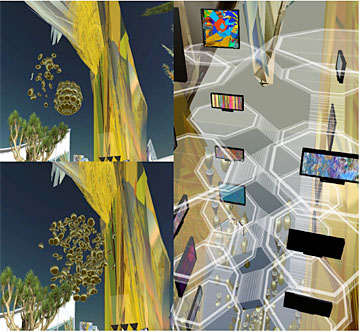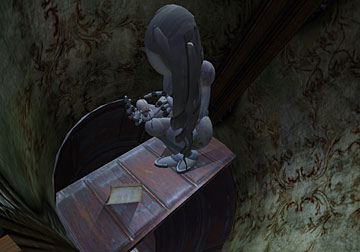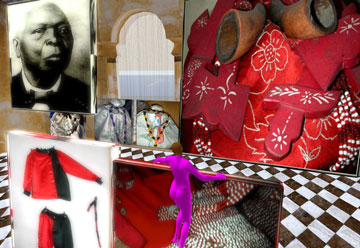
Cao Fei, RMB City. Art in the Twenty-First Century, production still, 2009. Season 5, Episode: Fantasy. © Art21, Inc. 2009.
William Saroyan wrote: The role of art is to make a world which can be inhabited.
Virtual art had its debut in a cave at Twin Rivers near Lusaka, Zambia, about 35,000 years ago, with two dimensional images of Stone Age man in his elemental environment, his world. Before it became synonymous with the digital realm, virtual meant existing in the mind, especially as a product of the imagination. Virtual can refer to things that mimic their “real” equivalents and it denotes work that is realized or carried out chiefly in an electronic medium. Virtual art goes beyond these definitions in Second Life. Second Life, or SL, is an online, virtual world where the use of 3D objects called prims creates the illusion of the third dimension on the two-dimensional surface of the computer’s screen. Observers become immersed, as 3D avatars that can freely move within a world that transcends physical constraints and traditional concepts of time and space. Virtual 3D art exists beyond the surface upon which it’s created, or the screen on which it’s displayed. Virtual 3D art exists in a world that is inhabited and where the viewer, embodied as an avatar, becomes immersed.
In other words, to truly experience immersive, virtual 3D art you have to go there.
I interviewed several artists who are early adopters of the online, virtual 3D world of Second Life. Second Life art ranges from scanned copies of public-domain works to primmed 3D paintings and complex kinetic sculptures that could only exist in perceptually immersive 3D space. These artists have already experienced varying degrees of success in “first life.” DanCoyote Antonelli (DC Spensley in material space) gave me a tour of his algorithmic, interactive, and immersive SL creations that purposefully reject anything that is inherently referential to the physical world.

DanCoyote Antonelli, details from Visions of Global Justice Installation. USC Annenberg School for Communication Network Culture Project, 2008. © All rights reserved.
DanCoyote Antonelli: My earliest work is four years old and embodies the conflict between modernism and post-modernism. What comes after postmodernism? Modernist Marvel, a tongue and cheek homage to modernist architecture, is actually a user interface that guides visitors through a number of algorithmic artworks from the early 2000s in QuickTime virtual reality that are mapped onto prims. Another site-specific work, entitled Hostile Space, explores the personal space of the avatar and demonstrates hyperformalism—a term derived from the combination of the words hyper (as in hypertext) and formalism (in the platonic sense) and is being used here to describe aesthetic self-expression without anthropomorphic, or representative context.
Simply put, virtual worlds offer many of the same benefits of physically visiting an art museum or gallery space, with the extra benefit of network transportability as well as the power of scripting aesthetic and conceptually compelling behaviors that are embedded in the environment.
Grapes of Math by DC Spensley (a.k.a. DanCoyote)
DanCoyote and several other artists working in Second Life contributed to Brooklyn is Watching, an art project that invited interaction between the two thriving art communities of SL and the Jack the Pelican Presents gallery in Williamsburg, Brooklyn. DanCoyote’s Tower of Light was voted one of the top 5, and eventually won the People’s Choice award last August. This work allowed the artist to push and revise the fundamental constructs of space and time through the use and control of the avatar. It consisted of several textured or colored, flexible prims (flexies) that allowed avatars to move across and upwards through them in real time.
New Media Consortium’s Virtual Worlds program supports SL artists, including DanCoyote Antonelli, and helps educational organizations explore the potential of virtual spaces. While an NMC artist-in-residence, DC has been working with Monroe College, IBM, University of Delaware, and many others who are providing in-world space for artists.
Since 2006, IBM has maintained a presence in Second Life that showcases immersive installations of virtual art and architecture as examples of the cutting edge of what is possible in 3D virtual worlds. Bryn Oh recently exhibited her Rabbicorn build on the IBM exhibition land parcel (sim). Bryn Oh is the SL alter ego of a Toronto-based landscape painter who has established herself as a skillful installation artist in Second Life. Dusan Writer supports Bryn by giving her the sim “Immersiva” to work on for free, and she gave me a tour of a few of her more recent installations, Vessel’s Dream and Condos in Heaven.

Bryn Oh, Willow. Brooklyn is Watching Final 5 Show, installation detail, 2009. © All rights reserved.
Nettrice Gaskins: What is the difference between art that is created for the physical world, or real life (RL) and art that is created in Second Life? What is so revolutionary, yet so conventional about Second Life art? Is it the lack of boundaries or a feeling of transcendence that attracts SL artists? As the observer/viewer/participant, are you allowing yourself to embody a virtual 3D self to experience this art? Is it a fleeting moment or can this experience be brought into the first life?
Bryn Oh: In first life, I am an oil painter who uses different techniques to draw viewers into my paintings. I paint on large canvasses to block out peripheral vision and remove distractions that can hamper viewers’ ability to be drawn into the paintings. In this way they won’t notice the things surrounding the border of the canvas that can take the attention away from the art. I use chaotic brush strokes to cause anxiety in the viewer. My use of color affects the viewer’s emotions and physical temperature of the work. My oil paintings, in the end, are 2D. You can’t go inside them. You are separate. These techniques can draw the viewer into my paintings, but the spell can be easily broken by distractions outside the borders of the painting.
With Second Life, I can create a painting that you can enter. For example, I can build a blizzard that avatars can walk into and become lost and disoriented. Avatars could wander aimlessly in a whiteout and come across an abandoned car in the snow. Opening the glove box, they find a note that furthers the narrative. I call my style of art Immersiva. It’s where I create environments that allow viewers to forget their first life surroundings for a time. My SL art helps viewers to suspend their disbelief and transports their imagination to another place. The difference between my first life paintings and my virtual environments is that persistent immersion is more successful in Second Life.
I believe this to be the next frontier within the art stream and I think we are approaching a time when full Immersiva is achievable.
Imagine this: you come home from a long day at work. Your boss is annoying and you have bills to pay. On your desk is your perfect environment. A commissioned world specifically designed for you or created by you. You put on a headset and the real world is blocked out. You are transported to a hill overlooking a valley. You sit in long grass that sways in a gentle breeze. Perhaps there are physical fans that are triggered to mimic the virtual wind. Or a timed spray to release a grassy summer scent. It may include a customized lover or a digital child like Milo, a programmed one, or perhaps a real human who you share this with. The Dali’s, Bosch’s, and de La Tours of the future will all create Immersiva.
Vessel’s Dream by Bryn Oh
Bryn sees Second Life not as a space to bring 2D copies of her real life paintings, but rather as a space to create interactive and exploratory experiences that allow patrons to step into her visions and creative stories.
—Pathfinder Linden of Linden Lab (maker of Second Life)
Many of Bryn Oh’s Second Life builds consist of several narrative 3D mini-installations which incorporate machinima to help tell the stories. Machinima, from machine cinema, is a technique that records the action in real-time interactive 3D environments, such as Second Life. Once immersed, viewers click on objects to find secret elements to help with the narrative. Occasionally, the movement of the avatar is restricted and the viewer must use his or her camera controls to discover new elements or scenes.
Bryn Oh: The idea is for people to accidentally discover these elements over time. It’s the excitement of discovery as well as finding a whole tiny world inside.

Maya Paris, Bicyclorama. Bluestocking Interactive Art Gallery, installation detail, 2009. © All rights reserved.
Maya Paris’ gravity-defying SL art installations challenge what we know to be real in physical space. She commented that Second Life is “an extraordinary medium with great potential for work that is inter-disciplinary, interactive, and immersive. The building and scripting tools make it possible to combine sound, images, sculptural and architectural elements and performance in innovative ways.”
Art Kahos: A collaborative art project by a group of 12 international artists—including Maya Paris—in Second Life, organised by Pirats.
For Alizarin Goldflake (Martha Jane Bradford in first life), virtual art production in Second Life has changed the way she creates art, both in-world and in material space.

Alizarin Goldflake, Come Go With Me, installation detail, 2009. © All rights reserved.
Alizarin Goldflake: Originally, my goal was to demonstrate that digital drawing could be used to create work that was equal in quality to work created with traditional media. Recently, however, the pixel has begun to emerge from behind the scenes and is not only integral to the process but also to the visual sparkle of the textures in the new drawings. I have been working in a direction that is entirely new for me, constructing digital collages out of sections of my digital drawings using a creative approach I discovered in Second Life. The method is similar to process art, in that the final image is not envisioned at the outset but emerges as a result of assembling, layering, and composing visual elements. New works incorporate machinima (video), live streaming, printed displays, photographs of SL work and SL-inspired collages on canvas, PowerPoint presentations, live demos, and a podcast interview.
Metempsyche’s Garden by Alizarin Goldflake
My virtual collaborator and real life mentor, Vu Sosa (Sharon Dunn) unpacks cultural, historical artifacts from her Virtual Cuban Journal as a 3D audio/visual installation, allowing visitors to interact and dialogue with each other in real time.

Vu Sosa, Virtual Cuban Journal, MassArt in Cuba, installation detail, 2009. © All rights reserved.
Vu Sosa: Because I investigate a variety of mixed-material formats, the Second Life platform provides archival solutions for a number of interdisciplinary studio/research projects related to cultural representation and digital heritage. SL serves as my digital photographic studio, high definition camera, multi-dimensional collage studio, and Spanish translation site. It is an immersive environment, offering new possibilities for interactivity and interdisciplinary juxtapositions. Visitors explore the Cuban images and new collaborations are formed. My SL journal is fluid and transforming as the dialogue changes.
The Second Life artists and art forms featured here clearly demonstrate what comes after postmodernism and are, arguably, an early phase of an artistic movement taking place in an artificial, interactive, computer-created “world.” These virtual artists are just a few of several who are discovering and reconceptualizing art in a virtual 3D frontier. We are seeing a fusion of forms, dimensions, Web-based platforms, and realities that is entirely new and still very much a part of the virtual art (time and space) continuum that promotes the growth of art practice in the 21st century.
Nettrice Gaskins is an artist and educator who bridges the actual and virtual worlds and explores how these realities can have a transformative impact on people’s lives and experiences when it can be fully implemented and realized. Her purpose is to bring together people, concepts, modalities, media, and worlds through art. Follow Nettrice’s blogs to explore writings on new media art and art in the classroom.




Pingback: My Art 2.1 Guest Blog Spot « SL Art HUD Blog Thingie:
Pingback: Blogalogue, Part 2: About ETeam | Art21 Blog